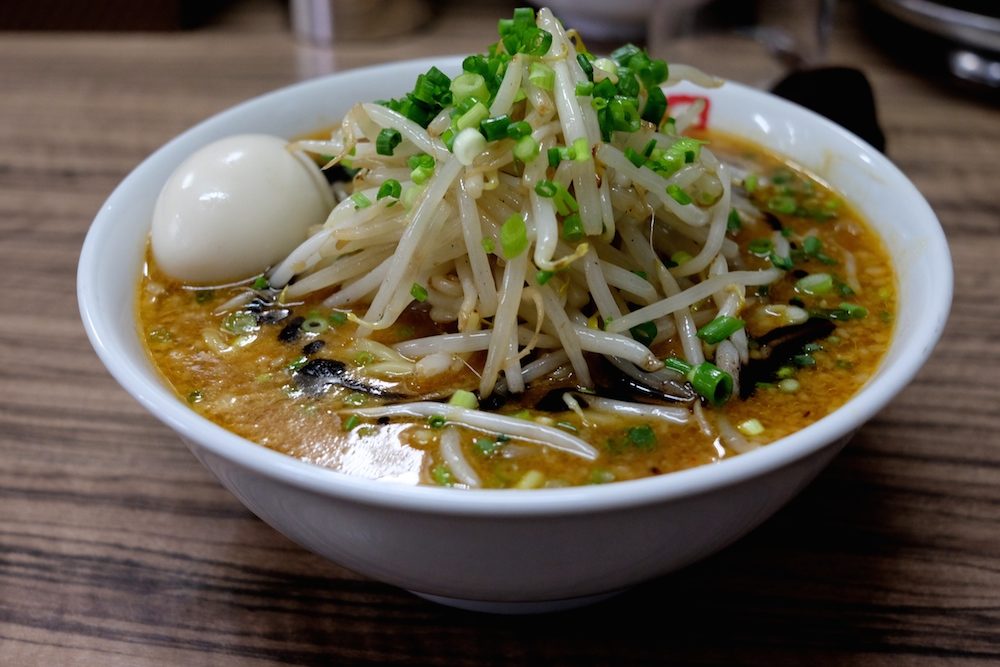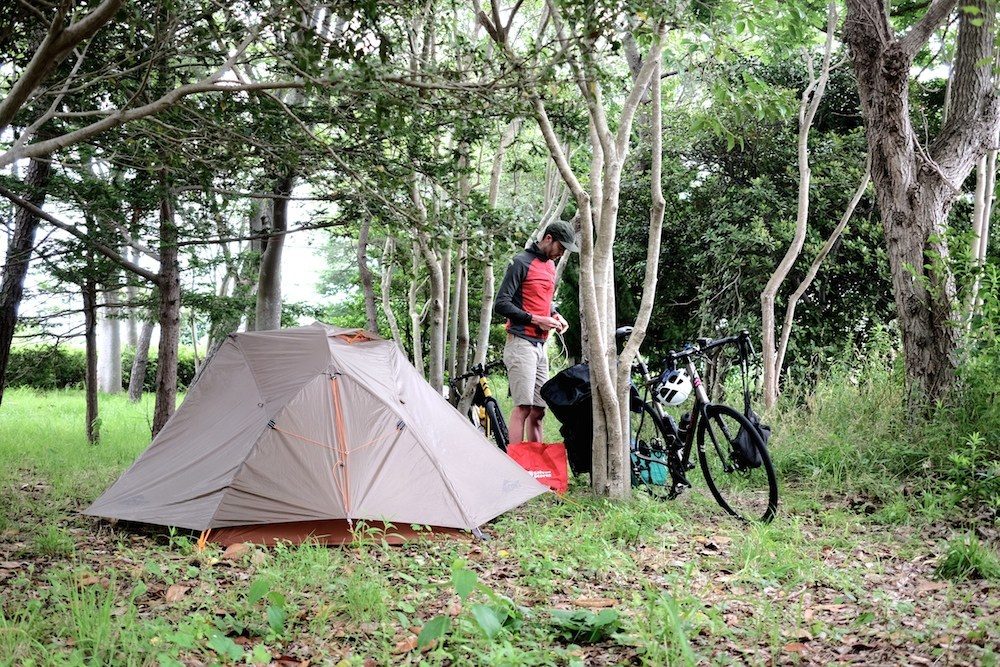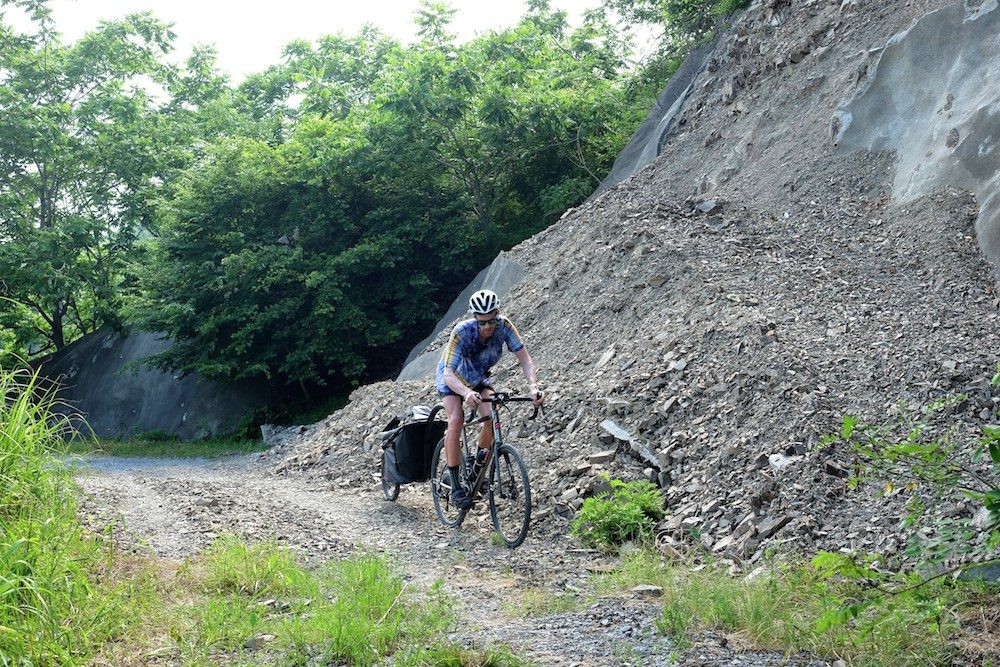Table of Contents
Japan is a dream destination for bike travellers. With a unique culture, incredible landscape, an abundance of great food and lots of places to camp – it’s a delight to go both bicycle touring and bikepacking in Japan.
I’ve now cycled around 5000km on the four main islands, and it’s safe to say that Japan is one of my favourite bike touring destinations.
Let me arm you with information so you can get the most out of your time in Japan.
Bicycle Touring & Bikepacking Japan

It’s easy to enjoy yourself in Japan but be prepared to work hard for your keep.
Japan is located near multiple fault lines, so it’s littered with mountains, volcanoes and steep winding roads. The backroads are almost always more hilly than the main roads, but this makes them all the more scenic.
What Bike Should You Take?
You can travel around Japan on any bike.
On my first trip to Japan, I cycled on a tandem touring bike with panniers, and more recently I rode a road bike with racing slicks pulling a trailer. I don’t think there is any perfect bike for everyone, but a bike with a couple of panniers will be comfortable, durable and will take you on mixed terrain.
The most important thing about your bike is that it should have a really small climbing gear ratio. I’m a very strong cyclist and found myself in my smallest gear (34x42t) multiple times per day – yep, it’s that hilly.
Click HERE for my low gear ratio resources; I recommend using as close to 20 gear inches as possible.
Routes
There are some excellent bike routes available for Japan. I’ve completed many of the routes listed below and can verify they’re all great.
The big advantage of following these routes is that they’ll shuffle you onto the smaller back roads which you normally wouldn’t find. They also provide the easiest way through the big cities, minimising busy roads and making navigation a pleasant experience.
JapanCycling.org has 4552km (2828mi) of routes from the south (Kyushu Island) to the north (Hokkaido Island). I’d recommend downloading the GPX files to use as a guide as they take in so many of Japan’s highlights.
The Japan Odyssey is a yearly, long-distance cycling event which has riders creating their own route around a series of checkpoints and mandatory roads. The course designers aim to include the best roads in Japan, so I’d suggest seeing if any of the following segments can fit into your tour.
Japan Odyssey segment details:
2017 Odyssey Tour
2016 Odyssey Tour
Rob from HokkaidoWilds.org has been busy establishing some really nice cycling options on Hokkaido. There are 1 through to 10-day cycling routes zig-zagging all over the island. You can easily connect up multiple routes for a month-long tour (or longer).
Given the heavy snowfall in winter, Hokkaido often has road closures. Bookmark this road information website because you may need to plan around them.
If you’d like to go exactly where I went on my 2017 tour:
1. The Tokyo to Hokkaido Commute
2. My Loop Around Hokkaido
Tunnels
You’ll come across multiple tunnels per day in Japan.
Tunnels are extremely noisy to ride in; the smallest cars sound like the biggest trucks. While initially quite scary, you will gain confidence after tackling a few. The Japanese drivers will reduce their speed well below 50kph/30mph in tunnels and only pass you when it’s clear. The longer tunnels have a footpath to the side that you can cycle on. Make sure you turn on your front and rear lights before entering.
Food
The Japanese food is simple, tasty and quite often healthy. Convenience stores are the gem of Japan, offering a broad range of small meals which will fill you up at any moment. You will often find multiple convenience stores within a kilometre of each other.
Supermarkets are located in most towns. They all have a large range of fresh local produce, tofu, noodles, bread, pasta and sauces. I normally prepare my own breakfast and dinner from supermarket produce because I can piece together large, healthy meals at a really low cost. Shop after 6 pm for 20-50% off the HUGE range of pre-prepared food.
Small restaurants provide affordable meals in most towns. Expect to pay between 500-1500 yen (US $5-15) for a lovely traditional meal which is typically only available in the local area. You’ll notice vast differences in the type of food available, region to region. Everywhere has its own speciality.
I travelled to Japan as a vegan (all of my trips are fuelled by plants). It was really easy to find everything I needed in both convenience stores and supermarkets, but a little more difficult in restaurants. I used the ‘Happy Cow’ app to great effect to find vegetarian and vegan places to eat.
Camping
Campsites aren’t too common on the main Japanese islands except for Hokkaido.
But here’s the good news: you can almost camp anywhere in Japan if you’re happy to wait until sunset and pack up early. I’ve camped in parks, temples and even museums. In towns with a river, there will usually be a grassy park running alongside it. The Japanese people are very accommodating and will almost never ask you to leave.
I regularly used this map of free campsites and onsens. I imported the data as a ‘KML layer’ into my smartphone mapping apps (Maps.me and MapOut) so that I could see when I was approaching a potential sleeping or cleaning location.
Note: the paid campsites in Japan very rarely have showers. More on that below.
Hotels, Guesthouses, Rider Houses
Hotels are relatively common across Japan and will typically set you back about 6000 yen (US $60) per night. Airbnb tends to be a more cost-effective solution – you’ll need to plan a bit ahead but you can get far more, for less. Hostels are available in larger cities and towns and you can expect a bed in a dorm for a little over 3000 yen (US $30) per night.
On the island of Hokkaido, there is an ultra-budget accommodation called a ‘Rider House’ available to motorbike and bicycle travellers only. These bare-bones establishments are typically located away from towns and are only open in the warmer months. THIS is a map of all of the Rider House locations on the island.
Trains, Buses, Ferries, Taxis
You can take your bike on trains provided it’s either in a bike box or packed in a ‘rinko’ bag. The latter involves removing the two wheels from your bike, putting them either side of your frame, and packing it all into a lightweight cloth bag. The bag doesn’t have to be fully closed, but it should be enough to not get grease or dirt on anybody.
You can get Rinko bags from all bike shops for between 3,000-6,000 yen (US $30-60), but some people buy bike covers and a bit of tape from a ‘100 Yen Store’ and make do for a one-way or temporary solution. Buses will require you to pack your bike into a Rinko bag too.
You can roll your bike directly onto most ferries. Every ferry I’ve taken has had a place for bikes, and sometimes they’ll strap your bike down to a railing. Ferries are a great way to connect up the hundreds of small islands off the coast of Japan.
When catching taxis, ferries, trains and buses, you’ll need to make sure you have cash. Most don’t accept credit cards, and if they do, they probably won’t accept international cards.
Keeping Clean
The onsen (communal bath) is a cultural institution in Japan.
Every town has one, simply ask around for its location. You’ll fold your clothes into a basket, get naked, wash yourself down and then be able to sit in any of the hot pools for as long as you like. Occasionally the natural onsens are free, but cheaper onsens start at about 200 yen (US $2) while expensive hotel onsens are about 800 yen (totally worth it!).
It’s unusual to find campsites that have showers, so if you’d like to have a good wash, make sure to find an onsen in the nearest town first.
When To Go
Japan is a really long country. This results in vastly different climates between north and south. The island of Kyushu (south) is almost tropical, while the island of Hokkaido (north) is freezing in winter and hot/dry in summer.
Monsoons tend to affect everywhere but Hokkaido, so expect heavy rain between July-September anywhere south of Tokyo.
Cycling in the North: June-August
Cycling in the South: March-May and September-December
Internet
You can find free internet at convenience stores (7Eleven, Family Mart and more recently Lawson) as well as tourist information centres.
But if you want to be a bit more mobile, you can hire an ‘egg’ from the airport which creates a wifi signal that multiple phones can connect to. These aren’t cheap but can be great for a short trip. SIM cards can be purchased from BIC Camera stores if you feel the need to have the internet everywhere you go.
With the abundance of convenience stores (seriously, it’s every corner) you can probably travel without mobile data.
My Recent Japan Adventure
Have A Question? Drop A Comment Below, Or Try THIS Facebook Group of Local Cyclists.











What is your experience riding a tandem bicycle in Japan. Is it still illegal in most of the country?
It is technically illegal – but as far as I know, it isn’t enforced to travellers. I didn’t have any issues for the two months I cycled there.
I can’t wait to read your opinion re trailer vs panniers…
I am thinking about getting this one http://www.extrawheel.com
hi, how do you transport your bicycle into Japan? i was thinking of using my bike box, but i can’t seem to find any place to store it for 2 weeks while i’m out cycling.
You throw away the cardboard box and find a new one when you leave. Or you strap it with wrap directly at the airport, as well as strap your panniers together.
Hi Alee, Thanks for this! I just got back from a one-month bicycle tour through Norway – my first big(ish) bicycle tour – and I can’t wait to do it again. Japan is very high on my list, so this is very useful. Do you have any recommendations on books about Japan and it’s culture/ landscape? And what was your experience with communicating with locals (language-wise)? Thanks again.
I just finished my second trailer tour yesterday. Should be some resources coming soon!
You might be able to find a hotel/hostel/host to hold it for you. If not, all bike shops get cardboard boxes when bikes are delivered. Just allocate half a day before you leave to finding one (we found two within 30 mins of searching).
I haven’t done a lot of reading about Japan, most of what I know is anecdotal or from my own experience. Communication with locals isn’t particularly common because the Japanese either don’t get to practice the English learned in school, or are too shy to use it. You can use various online translators to have a conversation if you need. We were lucky enough to stay with a few English-speaking locals via Couch Surfing and Warm Showers.
Thank you
Hi Alee, great post, thanks. Any hints about stoves and fuel for Japan? What worked best for you? Thanks, Daniel
We used a canister stove. We found one canisters at Snowpeak outdoors shop and another at a tools/car accessories/fishing type general store. Two canisters lasted five weeks!
Thanks Alee, good to know. Which kind of canister stove do you use btw? MSR Whisperlite?
It was a 360 Degrees Furno Stove.
Hi Alee
Since Japan is a short flight for me it’s on my list of places to visit. So how common is English there? Are there any Japanese words or phrases you’d recommend learning?
Thanks.
Phil
North Pole, Alaska.
I go to Japan every few years. Most young people speak broken basic English but they are not going to use it generally, so it is hit and miss. Generally I have found that people who work in stores that sell outdoor supplies for hiking tend to speak more English. Bikes shops are better sometimes too.
Thanks a lot Alee for this great information. I’m currently planning to cross Japan in August 2018 with my road bike. Starting in the far north (near Wakkanai) and finishing near to Kagoshima in the south. Normally I’ve stages of 150-200km a day. Can you recommend such a tour, also the far north and south part? If yes, should I take on the main island the north route along the see or your route from Tokyo to Hokkaido. Would be very thankful for any recommendations!
Hi Kurt. You’ll want to link up as much of the back road stuff as possible. They’re certainly the best roads for cyclists, however they tend to be steep and a little bit indirect. I’d use the JapanCycling.org routes as a general guide and make some modifications to suit how long you have and what you’d like to see. Alee
Thanks a lot Alee for your advice. Will now start the planning and would be happy to come back with some more questions!
Hello Alee,
Love the Post! My friend and I will be traveling to Japan for the first time from early April-late May this year (2018)and we would love to do it on bikes (for the adventure and to save train ticket money)! Do you know of any great and reliable places to rent bikes at a good price for those weeks? Do you have any tips for us first time Japan bike travelers? We’re thinking of going to these following places, any help and advice is greatly appreciated!! Thank you!
Tokyo, Kanto to Fujiyoshida, Yamanashi Chubu to Kyoto, Kansai to Osaka, Kansai to Nara, Kansai to Hida Takayama, Chubu and back to Tokyo, Kanto.
Between this article and my book “Bicycle Touring In One Hour”, you should have enough information to tour Japan confidently! Check out JapanCycling.org for routes, or if you’re mapping your own, a good way to do that is through Komoot.com to stay off busy roads. Sorry, not too sure where you can rent bikes.
when touring trough japan do you need a new real expensive tour bike, or could you just use your own fixed up bike and if it were to brake down buy a new one there ??
You can use any bike. I’d suggest packing light and avoiding any rough dirt roads to prevent part failures.
Great info – many thanks.
We’re looking to do Seoul -> Tokyo via the Busan – Shimonoseki ferry. Very helpful input. Thanks again.
Hi Alee,
A question about your gear.
What’s the bag you have on your back?
thank you
It’s an old Rapha Bonk Bag (musette). They don’t make them anymore, but you can find similar things if you search ‘cycling musette’ in eBay etc.
should i bring a bike with me or could i find a good deal in kyoto? like $350 with panniers….